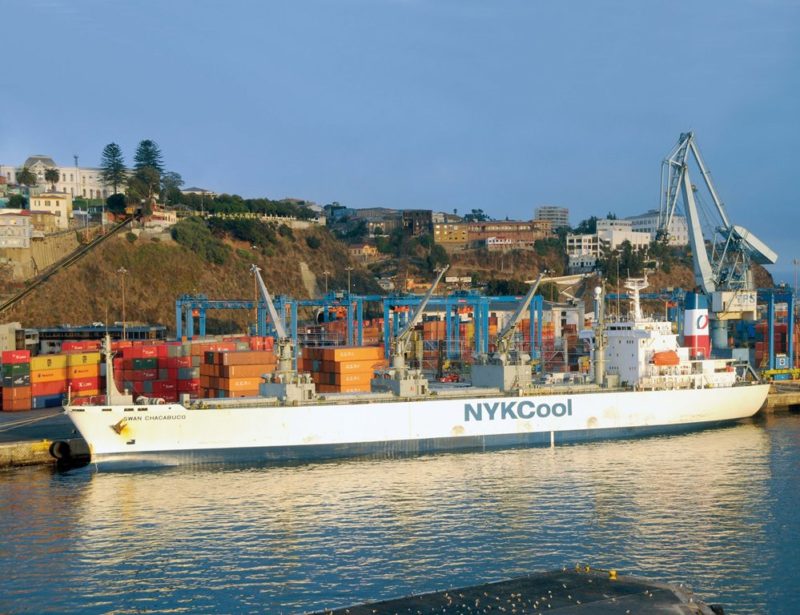
Empresa Portuaria Valparaiso (EPV) or the Valparaiso Port Company (VPC) is the manager of this busy port in Central Chile, lying 70 miles north west of Santiago de Chile, the capital. The port dates from 1810 when the town consisted of two villages, the Almendral and the Port, separated by the Cape on the seaward side. A wealthy merchant then built the Villarrutia dock at the front of the port where today the Head Office of the newspaper El Mercurio de Valparaiso (Valparaiso Mercury) is located. The first berths of any size were built in the 1820s and 1830s together with the first warehouses for the trade to Europe. The Pacific Steam Navigation Company (PSNC) of Liverpool took the premier place in the trade to the West Coast of South America when it was granted a Royal Charter in 1840, using small paddle steamers. The opening of the Panama Canal in 1914, allowed passenger and cargo services to the U.K. from Valparaiso to be greatly increased along the 3,100 kilometres of the Chilean coastline.
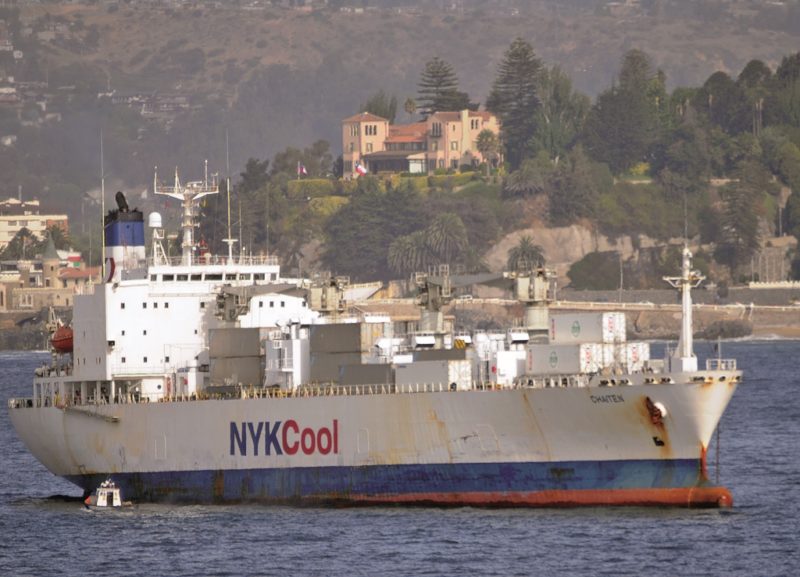
VALLEY OF PARADISE
Valparaiso or ‘The Valley of Paradise’ is the gateway to the fertile heartland of Chile, as well as to the capital Santiago de Chile and the Andes mountains. These high mountains restrict Chile for the vast part of its length to a narrow strip of coastal land around 150 miles wide. The seafarer or the cruise passenger approaching the port by sea has to absorb the vista of high mountains all around the port. Downtown Valparaiso has old, narrow cobbled streets with museums, plazas and the huge dome of the National Congress Building. A series of very steep hills form a long crescent of high ground all around the port, with a multitude of many colourful houses, where one can paint their walls with a paint spray can if permission is granted by the houseowner. This multitude of street art gives life to this very hilly assortment and maze of escaleras (steps), ascensors (lifts), cable cars and funicular railways that lead to blind alleys, where visitors often end up completely lost.
During the Golden Age of Valparaiso (1848-1914), the city received large numbers of immigrants primarily from Europe. The immigrant communities became separate districts for Spanish, French, Italian, British and German nationals up the steep hillsides, founding their own noteworthy cultural and economic institutions, preserved today as ‘Zonas Tipicas’ or National Historic Districts. A total of 28 ‘ascensors’ or lifts were built at Valparaiso for citizens to reach their homes on the lofty heights of the city, of which a dozen were still in operation in 2010. They had the names of the Artilleria Funicular Railway built up Artillery Hill, and the Ascensor Conception (built in 1883 operated by steam and still in service), Ascensor Polanco (the only vertical lift), Ascensor Cerro Cordillera (built in 1887), Ascensors Baron, El Peral, Reina Victoria (Queen Victoria), St. Augustine, Florida, Butterflies, Nuns, Larrain, Villaseca and Mountain, as well as others that have not been preserved. The Escalera Piano of gently sloping steps have some aficionados among the older and less agile members of the community.
The original native South American Chango nomads existed by fishing in the Bay of Valparaiso. The Spanish conquistadores arrived in 1536 aboard their galleon Santiaguillo, commanded by Juan de Saavedra, and supported the Spanish expedition of exploration around the Bay of Valparaiso of Don Diego de Almagro. They named the village and the bay after their native village of Valparaiso de Arriba in Cuenca Province in Central Spain. During Spanish colonial times, Valparaiso remained as a small fishing village with only a few small houses and a Church, the Iglesia de la Matriz del Salvador founded in 1559 by the Bishop of Santiago. Francis Drake raided the village in 1578, taking loot including gold treasures and a chalice of solid silver from the Church, which is now a National Historic Monument of Chile. The Battle of Valparaiso was fought in 1814 between American and British frigates during the Anglo – American War of 1812 and its aftermath. Chile became independent from Spain in 1818 using the growing power of the Chilean Navy. Many beautiful plazas or squares were then built in Valparaiso including Plaza O’Higgins named after a great Chilean naval hero, Plaza Bismarck, Plaza Victoria, Plaza Yugoslaye and Plaza Soto Mayor, the latter square is lined with statues and fine official buildings including the Chilean Navy headquarters.
The Palacio Baburizza is the former residence of Croatian businessman Pascual Baburizza, who built this grand house in 1916 using Italian architects and craftsmen to design the many turrets and gable ends, and which eventually became a museum in 1971 and was declared a National Historic Monument in 1976 and is open to visitors. La Sebastiana is a very high four storey hilltop house built above the port and city by Pablo Neruda, the great Chilean poet, with his writing desk and personal effects still preserved today in the Casa Museo Sebastiana and open to visitors.
The old world atmosphere of Valparaiso and beautiful colours of the ‘Nacional Bellas Artes’ or National Fine Arts buildings are due to the original European inhabitants wanting to bring a touch of European elegance to their new home in Chile. The maze of cobbled streets and Neo – Classical buildings with unique architecture are reminiscent of the opulent Golden Ages of Spain, Southern Europe and the Mediterranean rather than the South West Pacific coastline. Valparaiso is best explored on foot, and the ‘ascensors’ and ‘escaleras’ were built for that purpose, as these romantic lifts and funicular railways climb the notoriously steep hillsides of Valparaiso. Empresa Portuaria Valparaiso (EPV), the port company, is surrounded by the Altamirano road on its landward side from where a great view can be obtained from the highpoint of 21 de Mayo (21st May) using the Ascensor Artilleria to reach it.
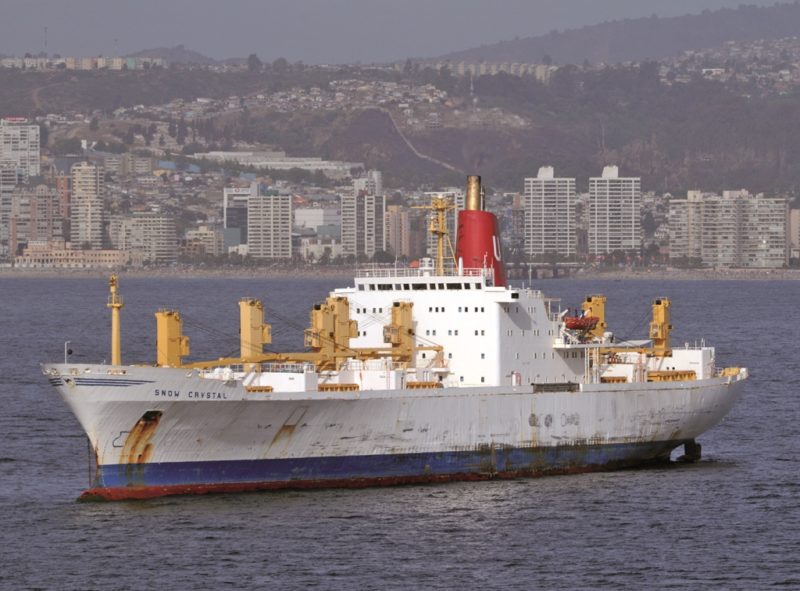
Unfortunately, Valparaiso has suffered great damage in the past from several earthquakes with tectonic plates colliding and sliding deep under the foothills of the Andes mountains, the first on 18th August 1906 on a 8.2 magnitude on the Richter Scale, and others on 22nd May 1960 with a magnitude of 9.6 causing 5,700 deaths in the Valdivia area, another on 3rd March 1985 causing 177 deaths and major disruption to the Port of Valparaiso, another on 27th February 2010 with a magnitude of 8.8, another on 25th March 2012 with a magnitude of 7.1, and another on 24th April 2017 with a magnitude of 6.9 and around one thousand aftershocks, and the latest on 1st August 2019 with a magnitude of 6.8.
The central part of the city of Valparaiso was declared an UNESCO World Heritage Site in 2003, with the Conception and Cerros Alegre areas preserving the architectural and social highlights of former European families. The Anglican Church of Saint Paul, the Paseo de Catorce Asientos (Street with fourteen seats), the Paseo Pierre Loty, the Lutheran Church and the Plaza Echaurren, and the historic Castillo San Jose, which is home to the Lord Cochrane Museum of the Sea, are all worth visiting by the tourist.
The beach resort of Vina del Mar is called the ‘Garden City of Chile’ because of its abundance of green spaces and flower beds. This resort is only six miles up the bay from Valparaiso with grand mansions and carefully landscaped gardens with palm trees lining the streets, together with a large working clock covered with and made from flowers. Vina del Mar is home to the National Botanic Garden of Chile with rare specimens of plants from all over the world, and the world renowned Festival Internacional de la Cancion (International Song Festival) held here every February after the first such festival was held in February 1960.
The Fiesta Pirotechnico (Fireworks Festival) is celebrated during the last three days of the year in Valparaiso, with the roads and railways busy bringing in many citizens from Santiago as well as from all over Latin America to watch a 30 minute fireworks display on the eve of the New Year, as well as other celebrations and attractions during the three days of festival. The city of Valparaiso has a population of 284,630 with 930,220 residents living in the Greater Valparaiso Metropolitan area, with fruit growing, textiles, sugar refining, and paint, shoe and chemical factories as the principal industries.
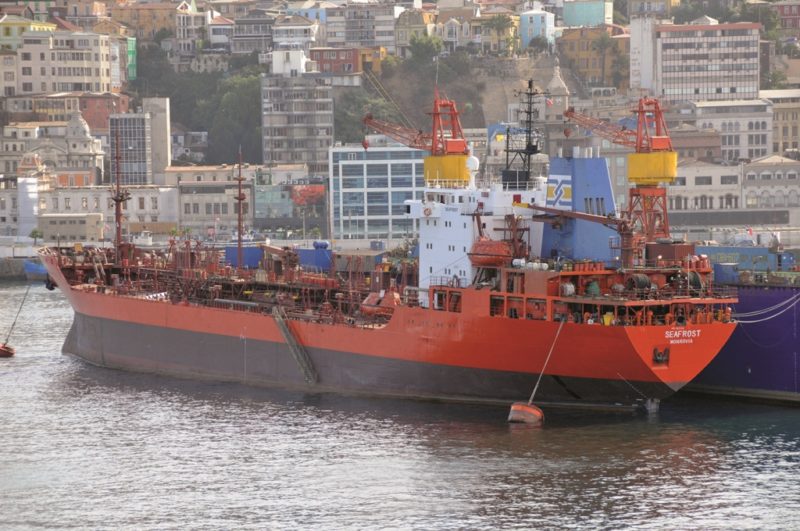
THE PORT OF VALPARAISO
The Port of Valparaiso is located at 33°01′ South, 71°38′ West, and had new wharves and docks built between 1870 and 1876, which were in service until 1979. A passenger berth called Muelle Prat was completed in 1877 with a large wooden enclosure that extended several metres to the edge of the harbour, and which today is used by local citizens as a walking and recreational area and for viewing the shipping in the port from harbour level. Government funds were approved on 7th September 1910 for the Port of Valparaiso and the Port San Antonio for further development, as well as for the setting up of the newly created Ports Commission of Chile. The new Espigon wide rectangular pier allowing two large ships to load or discharge on each side, and the Muelle Baron was opened in October 1912.
A great port expansion period occurred between 1910 and 1930 and a very long outer breakwater built, together with new piers and wharves. The future President of Chile, Augusto Pinochet, was born in the port in November 1915, with the Battle of Coronel fought a year earlier off Valparaiso on 1st November 1914 between the German East Asia Squadron of cruisers and the British West Indies Squadron, sinking two British cruisers, with the German squadron staying on in Valparaiso harbour before continuing around Cape Horn to the Falkland Islands, where they were decisively routed by British battlecruisers, leaving only one German cruiser left afloat to escape at high speed.
A large number of port warehouses were built in the decade between 1922 and 1932, with four of great length on the berth that today is Container Terminal 1. Three sister steam tugs were built between 1929 and 1931 by the Bow, McClachlan yard at Paisley for harbour towage at Valparaiso, named Colocolo, Buzo Sobenes and Corneta Cabrales, as well as two Chilean Government twin screw tankers named Maipo and Rancancagua of 6,000 dwt for naval use by the Armstrong, Whitworth yard on the Tyne. Chile had the unenviable accolade that the country was the worst economically affected country in the world during the Great Depression of 1930 to 1935.
Chile remained neutral during two World Wars, and then in the 1950s there was a growing movement to State control of the 65 large and small Chilean ports, with Valparaiso and San Antonio just to the south, and the nitrate ports in the north of Arica, Pisagua and Antofagasta the first to be taken under State control. The Empresa Portuaria Chilena (Emporchi) State owned port company was set up on 6th April 1960 as a central but independent administrative entity from the Government of Chile. Ten larger Chilean State owned ports were eventually managed by independent port companies in order that private investment in container terminals and ro-ro berths could be made. Emporchi brought a sense that Chilean ports could be developed to a far greater degree than had previously been attempted in the vast majority of her small ports.
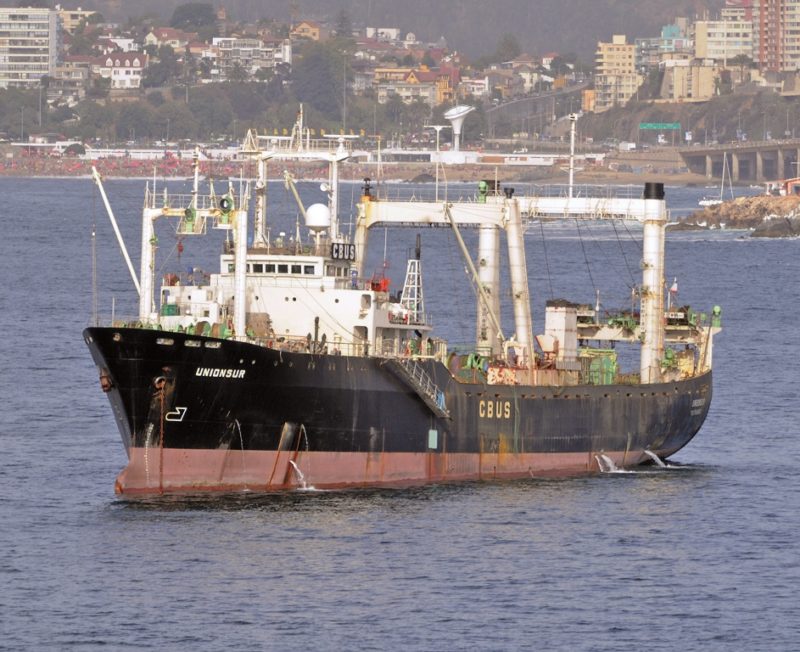
Emporchi began its national work of building new port facilities, and completely replacing those of the ports of Valdivia and Puerto Montt that had been destroyed by an earthquake. Emporchi built new general cargo terminals, oil and gas terminals, dry bulk quays for the export of salt, iron ore, copper concentrates and copper ingots, liquid and dry bulk chemicals to improve the national economy. The cabotage trade in the central and southern coasts of Chile included the Port of Valparaiso, which handled around 300,000 tonnes in this trade, with four engines aft passenger and cargo ships of 350 grt completed between 1960 and 1963 for the trade. The quartet were built by the Chantiers Navale Franco-Belges yard at Villenueve la Garonne in France as Calbuco, Rio Baker, Quellon and Capt. Luis Alcazar, named after a famous Chilean Antarctic explorer. They had a single hold served by a central mast with two derricks, with Capt. Luis Alcazar also often used on Chilean expeditions to the Antarctic.
At the end of the 1960s, the Emporchi national port structure was well organised with 95% berth occupancy rates, and port congestion had been reduced at Valparaiso, San Antonio and the other big Chilean ports. President Salvador Allende was overthrown in 1973 by a military junta uprising to place President Augusto Pinochet as the Head of a Military State. The Port of Valparaiso in 1980 had a total throughput of cargo of almost two million tonnes of general cargo, dry bulk, liquid bulk and reefer cargo, and included 38,400 TEU of containers. Ten years later in 1990, the throughput of imports and exports had reached four million tonnes with 130,775 TEU of containers including some transhipment. The number of ships passing through the port had passed the magical one thousand figure in 1988, and the figure for 1990 was 1,098 ships. This included container ships, general cargo ships, multi-purpose ships, ro-ros, tankers, coastal passenger ships, LPG gas tankers, reefer ships, lighters and fish factories.
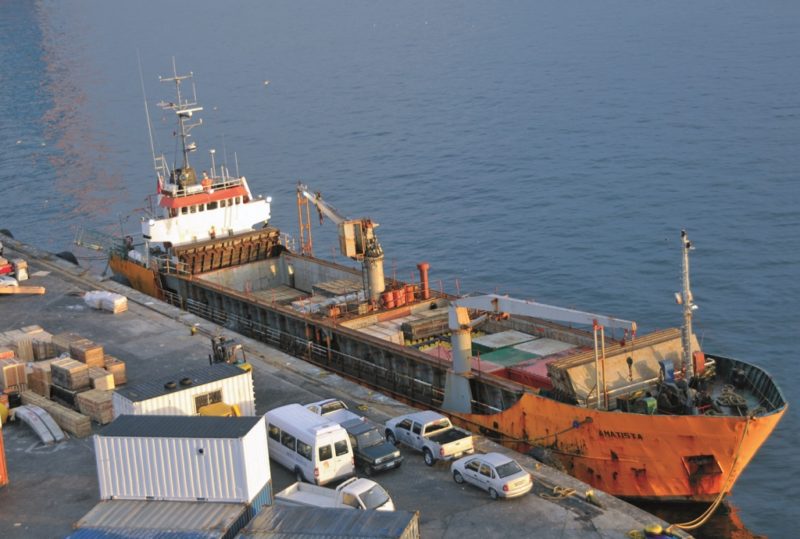
By the end of the decade of the 1990s, the Port of Valparaiso was owned by the Empresa Portuaria Valparaiso (EPV), created on 19th December 1997 in a regional port structure that also included the big port of San Antonio, just to the south of Valparaiso. The EPV Board has five directors and the EPV Workers Representative as a Public Administrator and elected annually. The regional structure had been created throughout Chile to improve the commercial nature and infrastructure of regional ports according to user needs. The Empresa Portuaria Valparaiso (EPV) for the Port of Valparaiso operates independently from the Empresa Portuaria San Antonio (EPSA) in a regional structure, with the port management now done by these two private companies, with the exception of pilotage and most customs requirements. The two sister ports finance themselves through the generation of port dues, port services, hire of equipment, and ancillary sources of revenue, but the Chilean Government reserves a central function to obtain better international loans and terms and conditions of repayment that can be sourced at State level. The EPV maintains four concessions contracts with important companies in Chile to enhance the competitiveness of the port, with an Annual Sustainability Report issued for port traffic, logistics, security and technology.
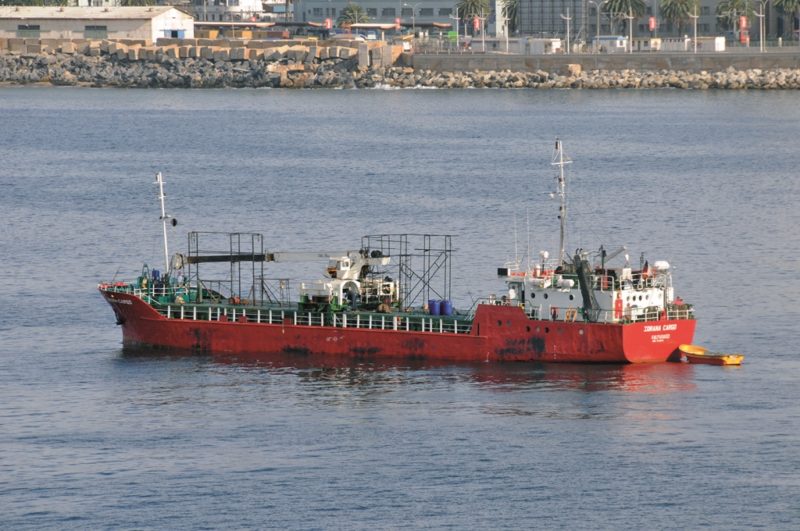
1990 EPV VALPARAISO PORT
PERFORMANCE FIGURES
Berth Utilisation 42%
Berth Occupancy – 60%
Merchant Ship Arrivals – 984
Port Throughput – 0.42 million tonnes per berth
Average Time in Port – 40.2 hours
Average Container Ship
Time in Port – 14.5 hours
Ship productivity per hour – 85.0 tonnes
Number of Port Employees – 350
Work Shifts – 3 of 8 hours
Port infrastructure had been badly damaged during the 1985 earthquake, leaving the maximum weight restriction for heavy loads and project cargo at a lower level until full repairs had been made by 1990. The port is subject to prevailing south westerly winds as most wharves are open to the ocean, and north westerly storms can also cause closure of the port on some occasions.
RECENT CRUISE SHIP and
PASSENGER ARRIVALS
2007/08 48 115,900
2008/09 38 100,786
2009/10 27 66,423
2010/11 21 51,138
2011/12 21 59,574
2012/13 24 66,588
2013/14 23 65,927
2014/15 20 64,368
2015/16 26 93,856
2016/17 23 75,272
2019/20 28 30,788
2020/21 22 27,985
The average number of cruise ship calls per annum between 2007/08 season and 2016/17 season was 27 cruise ships, while the average number of cruise ship calls for the combined 2019/20 and 2020/21 seasons was 25 cruise ships per annum, with 30,000 passengers arriving in the 2019/20 season.
It should be noted that some of the 2019/20 cruise ship calls did not take place due to the Corona Virus pandemic as the season finished early on 15th March. Celebrity Eclipse was refused entry at Port San Antonio on 18th March 2020 and sailed north to Valparaiso, where 65 Chilean national passengers were allowed to disembark before the cruise ship sailed for San Diego on the California and Mexico border. The cruise ships Azamara Pursuit and Costa Deliziosa were also diverted to Valparaiso from San Antonio at this time.
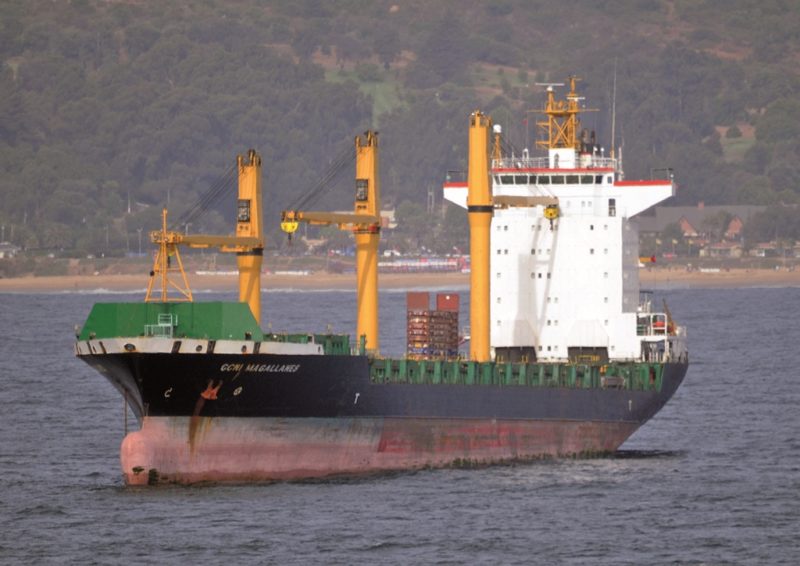
COMBINED SCHEDULED CRUISE LINE CALLS for 2019/20 and 2020/21
Viking Ocean Cruises 9
Silversea Cruises 9
Hurtigruten Cruises 7
Hapag-Lloyd Cruises 6

Le Ponant Cruises 4
Phoenix Seereisen 2
Scenic Cruises 2
Global Cruise Line 2
Carnival Cruise Line 1
Japan Grace Cruises 1
Costa Cruises 1
MSC Cruises 1
Fred Olsen Cruises 1
Noble Caledonia 1
Plantours & Partner 1
Azamara Cruises 1
One Ocean Expeditions 1
GRAND TOTAL 50
The biggest cruise ships due to call at Valparaiso during these two seasons (October to April) were Carnival Panorama of 133,868 grt on Christmas Day 2019 for the festival period, and MSC Magnifica of 95,128 grt on 2nd October 2020 which didn’t take place due to Covid.
There are also cruises south to the Lakeland Area of Southern Chile, as well as the Hurtigruten and other cruise lines operating down the full length of the western coast of South America. These cruises explore the wide variety of climatic, forest, desert and mountain environments.
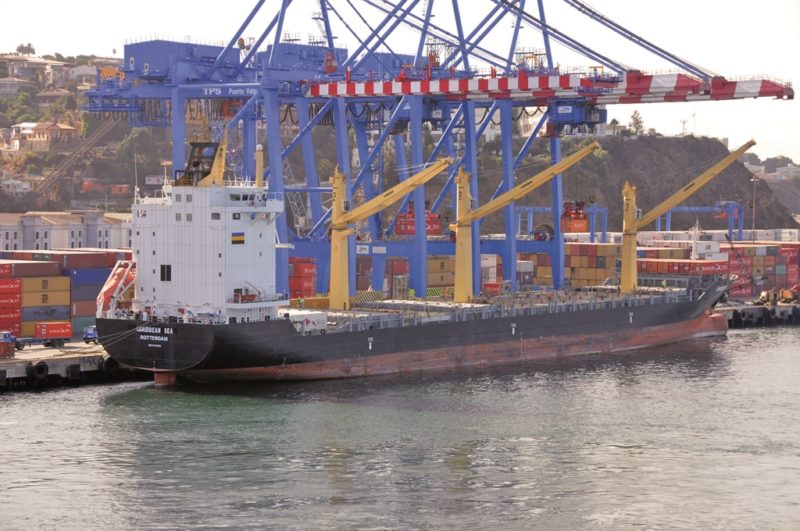
EPV VALPARAISO PORT FACILITIES
CONTAINER TERMINAL 1 (TPS) South Pacific Terminal
Five container ship berths including a side berth in an area of 14.62 hectares with Berths 1 to 3 having a total length of 740 metres and alongside depth of 14.1 metres, while Berths 4 and 5 have a total length of 366 metres with an alongside depth of 9.4 to 10.5 metres. The concession to run the terminal was awarded in August 1999 to TPS (Terminal Pacifico Sur Valparaiso) to run for 30 years with an investment project for the extension of Berth 3 and structural improvements at Berths 4 and 5. The terminal was opened on 1st January 2000.
CONTAINER TERMINAL 2 (TCVAL) Cerros (Hills) de Valparaiso Terminal
Container ships, cruise ships, reefers, general cargo and multi-purpose ships berth at a 6.4 hectare terminal with three berths. OHL Concessiones S.A. was awarded a concession for Container Terminal 2 in the port in 2013. Berth 6 is of length 245 metres and alongside depth of 8.4 metres, while Berth 7 is of length 120 metres and alongside depth of 6.9 metres, and Berth 8 is of length 240 metres with alongside depth of between 8.9 and 9.3 metres. The terminal is parallel to the main quay of the harbour, while there is also the Espigon or ‘jutting spike’ pier, which is a wide rectangular pier jutting out into the harbour, with good loading and unloading berths for large bulkers on either side. The bulk carrier Nordtajo of 38,550 dwt arrived at this berth on 6th May 2020 with a bulk cargo, she is owned by Klaus Oldendorff of Cyprus and was built in 2017 by the Jiangsu yard in China.
PASSENGER TERMINAL (VTP) Valparaiso Terminal de Pasajeros
This terminal is for passengers boarding or disembarking from cruise ships, with a total terminal area of 10,200 square metres and a lounge and reception area of 4,200 square metres and a parking area of 6,000 square metres. Valparaiso Terminal de Pasajeros S. A. (VTP) was granted a concession to run the terminal for 30 years in September 2002 with a start date of three months later.
MUELLE PRAT
This wharf lies between Terminal 1 and Terminal 2 in the port, and is also a public viewing point for seeing ships in port close up, and has craft shops and launches leaving for tours of the Bay of Valparaiso. The EPV Head Office is at Avenida Errazuriz 25 in Valparaiso near this waterfront area.
ZEAL (Zone Extension for Logistics Support) is an entry gate 11.6 kilometres from the port where cargo loads for entry to and exit from the port are checked and co-ordinated, including all document checks and inspection of cargoes checks. ZEAL was officially opened in May 2005. The ZEAL Sociedad Concessionaria S. A. (ZSC) was awarded the contract to operate ZEAL in December 2007 for 30 years with a start of operations date in May 2008. Co-ordination with the EPV is carried out by the website Silogport, which interconnects the freight carriers of the logistics chain of foreign trade allowing them to monitor and trace the flow of their cargo. This website is made up of three sections for management, operations and services, and can extend these functions to different links in the logistics chain e.g. other port or land container depots and the different routes they use to reach EPV.
EPV VALPARAISO PORT EQUIPMENT
Panamax Container Gantry Cranes 9 /35 tonne capacity
Rubber Tyred Gantry Cranes (RTG) 12 / 35 tonne capacity
Berth Cranes 24 / 35 tonne capacity
Mobile Cranes 10 / 50 tonne capacity
Frontloaders for containers 12 / 36 tonne capacity
Reach Stackers for Containers 12 / 36 tonne capacity
Forklifts 243 / 12 tonne capacity
Tractors 17 / 8 tonne capacity
Trailers 247 / 30 tonne capacity
Rail wagons 100 / 75 tonne capacity
Pilotage is compulsory for all vessels, with the approach channel depth between 12.5 and 13.7 metres, cargo piers alongside depth of 5.0 to 6.1 metres, oil terminal alongside depth of 14.0 to 15.2 metres, and a good anchoring depth offshore of more than 23.8 metres.
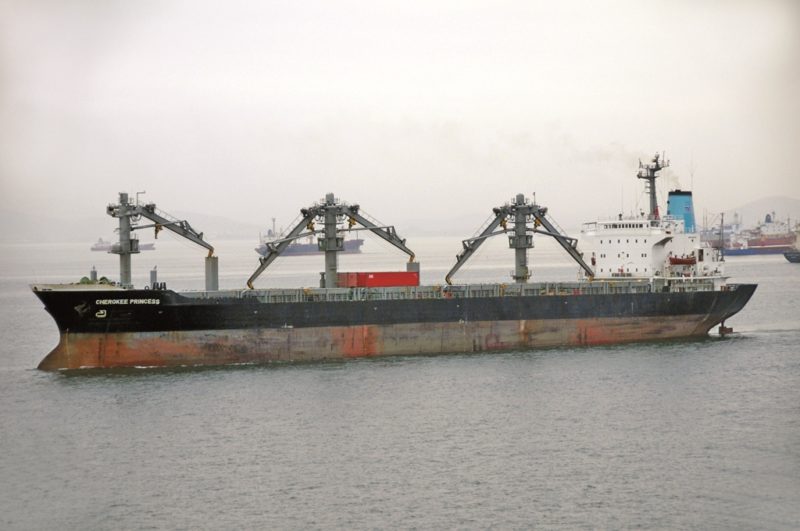
CURRENT and FUTURE PORT MASTERPLAN DEVELOPMENTS
The SILCOMEX (System for Information, Logistics and Communications of Foreign Exterior Trade) project was begun in 2011, as well as a start on the Port Standards Project between the EPV and major shipping lines. The centenary anniversary of the port was celebrated in October 2012, and the First Port Sustainability Report was prepared and published in 2013. OHL Concessiones S.A. was awarded a concession for Container Terminal 2 in the port in 2013. An historical throughput highpoint figure was reached in 2014 with over 11 million tonnes of cargo and ver 1 million TEU of containers handled. The Empresa de los Ferrocarriles del Estado (Chilean State Railways) signed an agreement with the EPV for rail development work on the proposed new Yolanda Container Terminal 3 in 2015.
The Empresa Portuaria Valparaiso (EPV) received a major award from the World Travel Organisation for becoming a major cruise port of South America in 2016. EPV completed the purchase in 2018 of the ruins of the former Subercaseaux Palace, built in 1895, and completely destroyed by a gas explosion in Serrano Street in 2007, which left only the façade standing. It will be part of the restoration of an area in the north east part of the Bay of Valparaiso.
The Yolanda Container Terminal 3 will be built as a large container terminal for three Post Panamax size container ships at three berths in an area of the Muelle Baron and Playa Caleta sector. A central element in the construction of this new terminal is the Cabriteria Access project for trucks to enter the terminal directly without interfering with the urban city roads. The new container terminal is part of the EPV Masterplan, which was originally issued in 2000 and updated in 2018 to expand the planning horizon for the next fifteen years until 2033. This new container terminal will have to compete with two big container terminals at the nearby Port of San Antonio, the PCE (Puerto Central) and the STI container terminals.
SOCIBER FLOATING DOCK REPAIRS and SHIP’S AGENTS
There is a large moored floating dock with the name of Valparaiso III of 10,000 tonnes lifting capacity, and painted blue with ‘SOCIBER’ in large white block letters in the middle of the harbour and visible from all vantage points. Vessels up to 165.5 metres overall length and 24.3 metres in the beam can be accommodated for regular dry docking, steelwork, hydraulics repairs, piping, hull treatment, tank coatings and engine repairs. Vessels can be moored on both sides of the outside of the floating dock up to 170.0 metres length overall and in a depth of water of 40 metres. The floating dock Valparaiso II had been lost in Valparaiso harbour in 1980 due to heavy weather.
SOCIBER (Sociedad Iberoamericana de Reparaciones Navales) was formed on 9th January 1981 as a joint venture between the Navantia Shipyard in Spain and the Asmar Shipyard in Chile. Floating Dock Valparaiso III was launched on 8th October 1983 at the Asmar yard and towed 240 miles to arrive in Valparaiso in early 1985. The Chilean general cargo ship Renacimiento of 16,999 dwt and built in 1970 was the first ship to use the dock on 22nd April 1985, her name means ‘rebirth’. Since then many ships have used this facility, including the container ship Titan, the Turkish bulker Balsa 55 of 6,830 dwt built in 1996, the Star Reefers Avelona Star and Viking Star, the chemical tanker Bow Pacifico of 18,670 dwt built in 1980 for Odfjell of Norway and managed by Southern Shipmanagement Ltda. of Chile until she arrived at Alang in India for breaking up on 25th March 2015, the products tanker Alpaca of 19,701 dwt, built in 2010 and owned by Ultragas of Santiago, local trawlers such as Ventisquero and the Victoria fish factory of Pesquerias Hispano S.A.
SOCIBER has a worldwide network of fifteen agents in Europe, and several on the Eastern and Western Seaboards of the U.S.A. and the Gulf of Mexico and also in Hong Kong to find enough repair work to keep the floating dock busy. The local port tugs Caranca of 417 grt and built in 2010 and Makohe of 472 grt and built in 2013 are used to dock and undock vessels from the big floating dock, together with a pair of Damen type ASD 2411 tugs of 75 tonnes bollard pull completed in 2016 as Mirlo and Tordo, which also serve at San Antonio.
Agunsa Chile S.A. act as ship’s agents at Valparaiso and San Antonio as well as contractors for the building of port infrastructure. Agunsa Chile S.A. was established in 1960 to build Container Port Terminals, International Logistics Solutions, and Passenger Terminals for ports and airports, and was given an exclusive contract by EPV for the development of a new Cruise Ship Terminal in 2017 for the Port of Valparaiso. Agunsa S. A. also has contracts for six other terminals in South America and one in Florida.
Ultramar S.A. of Chile have been ship’s agents at Valparaiso since 1952 when Capt. Albert von Appen began a maritime ship agency for Hapag Lloyd and Norddeutscher Lloyd of Germany. Ultramar began storage of cargo in warehouses in 1985 and the export of container cargo and investment in container terminals in 1993.
The pilotage services and towage services were begun in 1998, with freight forwarding and port concessions started in 1999. The company expanded to computer solutions for container and logistics documentation in 2007, and has handled project cargo since 2010. Ultramar Agencies are present today in fifteen worldwide countries and in three main lines of maritime business.
Ultratank is the tanker owning arm of Ultramar with around 80 tankers owned or chartered in a diversified range of tankers, including 17 chemical tankers of 22,000 dwt, 32 double hull crude oil tankers of 75,000 dwt operating in the Panamax International Pool (PI), 18 double hull product tankers of 45,000 to 55,000 dwt operating in the Clean Products Tanker Alliance (CPTA), and 11 double hull Aframax crude oil tankers of 115,000 dwt operating in the Andes Tanker Pool (AT). Some of the fleet have ‘Ultramar’ names followed by a Roman numeral, others have ‘Cabo’, ‘Aqua’, or ‘Seaways’ prefixes to their names with the Von Appen family still in control today from the Head Office in Avenida El Bosque Norte 500 in Santiago de Chile. The fleet have yellow funnels with a white and blue quartered central logo, and a central ‘U’ inside a circle.
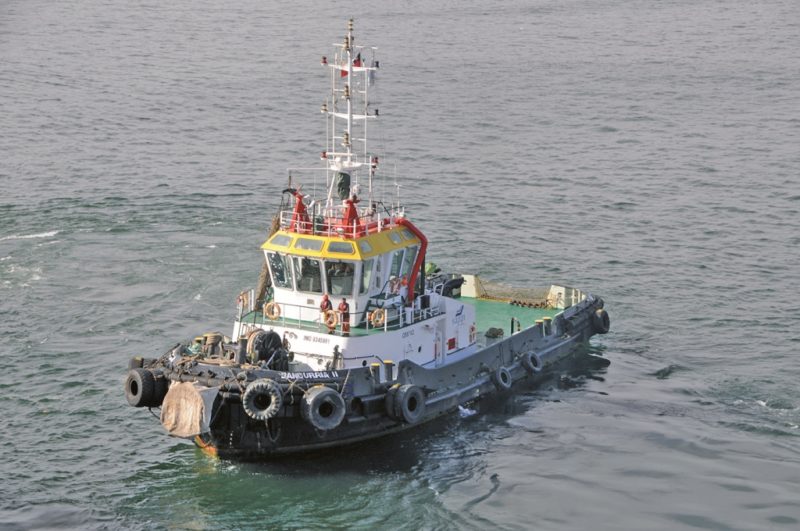
VALPARAISO SHIPPING
The container ship Cerinthus of Hadley Shipping Co. Ltd. in London arrived in Valparaiso on 27th September 2016, having moved down from Callao, to load containers after a long voyage that had started at Salerno in Italy on 16th August 2016 when she loaded a metro train with six railway carriages on charter to Hapag-Lloyd. Cerinthus is normally employed on charter to various shipping lines in the Mediterranean, visiting Malta, Alexandria, Istanbul and Piraeus. She was built in 2013 to a standard design of the Guangzhou Wenchong yard of 1,740 TEU capacity with five cellular holds and eight hatches on dimensions of overall length 176.8 metres, moulded beam of 27.4 metres, moulded depth of 14.3 metres and a loaded draft of 10.0 metres. She has twin container handling cranes of 45 tonnes capacity, and a good service speed of 20.6 knots from a MAN-B&W diesel of 16,660 kilowatts.
The metro train and six carriages, each of length 17.6 metres and 35 tonnes weight, had been loaded by special heavy lift cranes at Salerno in one morning, and after a voyage of 29 days she arrived at Callao in Peru to be discharged by heavy lift cranes for transport of the train and carriages to Lima, their final destination, by low loaders. A Hapag-Lloyd Special Cargo Team from Hamburg had prepared and supervised the loading and discharging processes. A total of 42 metro trains with 252 railway carriages were transported to Callao from Salerno by February 2019 at a value of 0.5 billion U. S. dollars. Cerinthus is registered in Castletown on the Isle of Man near Douglas to the Iona Shipping Co. Ltd., a company in the Hadley Shipping Group, which was established in 1926 and remains in business today as one of the very last British tramp shipping companies, trading with four Panamax and Kamsarmax bulkers named Cotinga, Cerafina, Clymene and Corato, as well as Cerinthus.
The two oldest and long lived shipping companies of Chile, CSAV and CCNI, were taken over by German shipping companies during 2014/15. Compania Sud Americana de Vapores (CSAV) was founded in 1872 and traded for 142 years of operations until 22nd January 2014, when it signed an agreement with Hapag-Lloyd that set the framework for combining their container shipping businesses. The merger made CSAV the largest shareholder in Hapag-Lloyd with a 30% share. The new container shipping company was the fourth largest in the world with a combined carrying capacity of over 1.0 million TEU and transported 7.5 million TEU per annum all across the world. The agreement became completely binding in December 2014, with the 18 Chilean large CSAV container ships keeping their Chilean names but with ‘Hapag-Lloyd’ on both sides of their hulls. A few CSAV car carriers were excluded from the takeover and continue to trade for CSAV with red funnels and black tops. CCNI was established in March 1930 as Compania Chilena de Navegacao but was taken over by Hamburg Sud on 17th February 2015 for $160 million, which included the agency functions of Agunsa and its Head Office in Valparaiso. CCNI discontinued their liner operations, leaving only the car carrier activities of CCNI.
Global Reefers was established as a new company in Valparaiso in October 2013 by combining the world leading reefer activities of Seatrade of Holland with Pacific Seaways of Chile, the largest fruit grower and shipping company in the country. Global Reefers N. V. began operations in Valparaiso with a Board of Directors equally represented from both companies, with Francisco Labarca, Chief Executive of Pacific Seaways, and Yontze Buitenwerf, President of Seatrade, on the Board. The Head Office of Global Reefers is at Avenida Errazuriz 755 in the Puerto Valparaiso Station Building, with Branch Offices in Lima, Los Angeles, Tampa, Wilmington (U.S.A.), Antwerp, Flushing and Sheerness. Pacific Seaways have used fruit carriers from Valparaiso since 1980 for clients Dole, Copefruit, Compania Frutera del Norte and Compania Agricola, with a big fleet of one hundred owned and chartered reefers today e.g. Aconcagua Bay, Magellan Strait, Humboldt Bay and Seatrade Orange, Seatrade Red and Seatrade White operated by the Seatrade Head Office in Antwerp.
Cool Carriers have been in the business of transporting cool and refrigerated cargoes worldwide for over fifty years, and today operate services from Valparaiso during the fruit growing season from December to May to the Eastern and Western Seaboards of the United States of America. The reefer fleets of Baltic Reefers, NYK Reefers, Lauritzen Cool, and Cool Carriers came together in 2014, and today they have a fleet of over thirty owned and chartered reefers with a nomenclature of prefixes ‘Cool’, ‘Baltic’, ‘Crown’ and ‘Wild’ e.g. Cool Express, Cool Lady, Cool Girl, Cool Spirit, Cool Explorer, Baltic Winter, Baltic Spring, Baltic Autumn, Baltic Summer, Baltic Jasmine, Crown Opal, Crown Topaz, Crown Jade, Crown Ruby, Crown Garnet, Crown Sapphire, Wild Peony, Wild Cosmos and Wild Lotus.
Volans Maritime have been established for over 35 years in the breakbulk and project cargoes trade from Hamburg, Antwerp, Bilbao and La Coruna to the South American ports of Barranquilla, Guayaquil, Callao and Valparaiso. They move heavy lift items such as wind turbines, blades and nacelles, railway carriages, and oil and gas fractional processing equipment on the Condor service of the Volans LG and NSC Group. Chartered ships include the German owned Condor Bilbao of 17,215 dwt built in 2012 with three heavy lift pedestal cranes on the port side, the Canadian chartered ship Tinos of 8,280 dwt and built by the Yichang yard in China in 2007 with two heavy lift pedestal cranes, Janet C of 12,914 dwt built in 2009 for Carisbrooke Shipping of the Isle of Wight, and vessels of the Clipper Group of Denmark e.g. Clipper Arrow, Clipper Ranger and Clipper Pennant .
The four masted barquentine Esmeralda is often seen on the inside berths of the Muelle d’Abrigo or breakwater at Valparaiso along with several Chilean warships. She was launched on 12th May 1953 at Cadiz and arrived at Valparaiso to a great fanfare on 1st September 1954 via Santa Cruz de Tenerife, New Orleans and the Panama Canal. She hoists 21 sails in full cruising mode with a total sail area of 2,870 square metres with a dizzy 159 feet climb to the top of her masts. She has a cruising speed of 17.5 knots under sail and 13 knots under diesel motors, and is the sixth Chilean Navy vessel to carry the name of Esmeralda. She has a sister four masted topsail schooner sail training ship in the Spanish Navy in Juan Sebastian Elcano, who was the first man to sail around the world during 1519 to 1522, his commander and compatriot Ferdinand Magellan (1840-1521) having died in the Philippines during the voyage. Esmeralda has since visited over 300 worldwide ports and acts as a floating embassy and trade exhibition ship for Chile. She has dimensions of overall length of 109.8 metres, moulded beam of 13.11 metres, and a maximum draft of 7.0 metres, and is a fast sailer winning the coveted Cutty Sark Trophy on two occasions. She carries a crew of 300 officers and men with ninety ‘midshipmen under training at any one time.
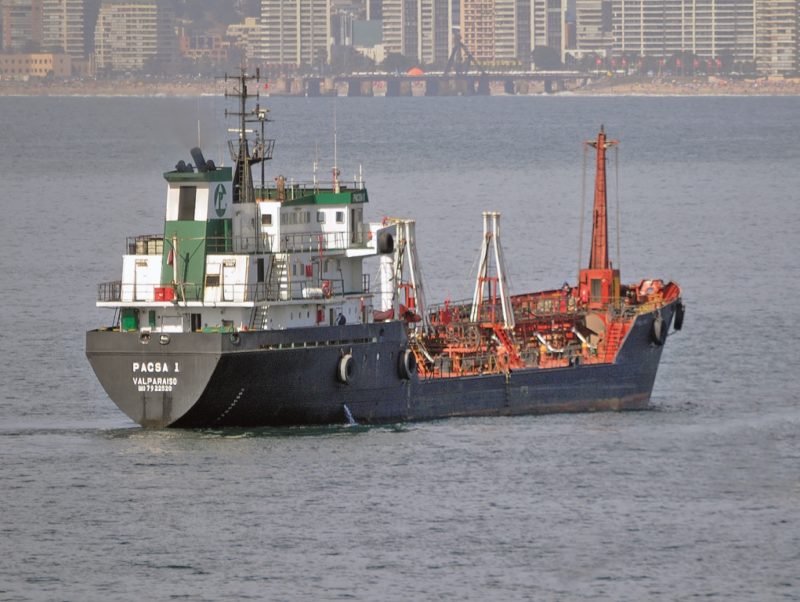
POSTSCRIPT
The Port of Valparaiso is well placed for future development of its core container trades, with two big terminals in service in Terminal 1 and Terminal 2, with the design work for Terminal 3 completed, and it is in the pipeline for construction work to begin. The fruit trade exports from December to May are a big trade in terms of value of produce, while other trades of bulk and general cargo, including exports of sugar, copper, wine, chemicals, textiles and footwear, and frozen fish are important. The ability to monitor and trace cargo online by the Silogport website from the freight output and input centre of ZEAL is a tremendous advantage over other container ports.
The city and port of Valparaiso offer a very colourful and interesting experience to the foreign tourist and cruise ship traveller, an experience that many find far more rewarding than they ever would have imagined when booking to arrive by cruise ship. There is so much to see in Valparaiso and a choice of several funicular railways to take one to the high ground above the harbour to view the snowy peaks of the Andes high mountains in the far distance.

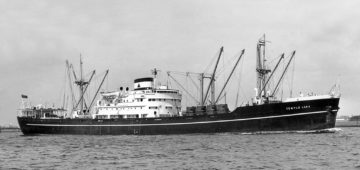



Comments
Sorry, comments are closed for this item